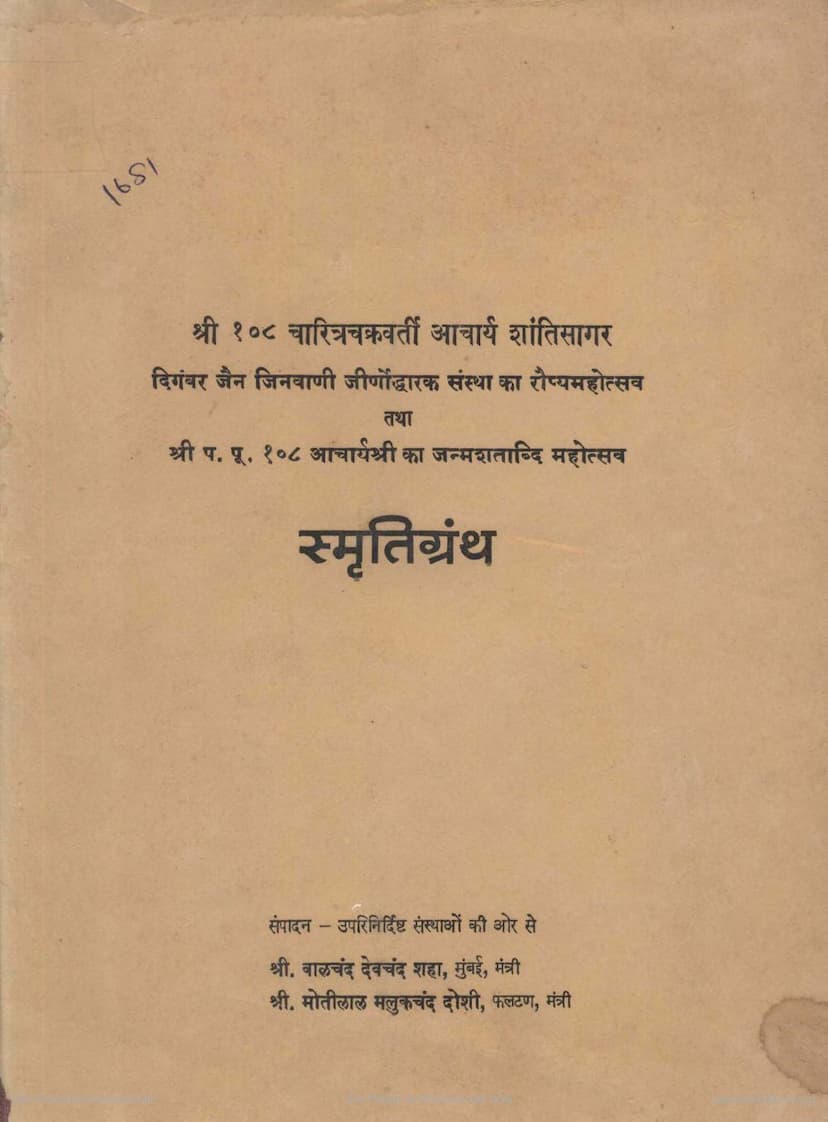Acharya Shantisagar Janma Shatabdi Mahotsav Smruti Granth
Added to library: September 1, 2025

Summary
This extensive Jain text, "Acharya Shantisagar Janma Shatabdi Mahotsav Smruti Granth," published by Jinwani Jirnoddharak Sanstha Faltan, is a commemorative volume celebrating the 100th birth anniversary of Acharya Shantisagar Maharaj and the Silver Jubilee of the Jinwani Jirnoddharak Sanstha. The book is a collection of essays, biographies, memoirs, and scholarly articles dedicated to Acharya Shantisagar Maharaj and the preservation and propagation of Jain literature.
The primary objective of the book, as articulated in the editorial (Page 4), was to honor the profound legacy of Acharya Shantisagar Maharaj. He was instrumental in the revival and dissemination of authentic Jain scriptures, particularly the ancient Digambar Jain texts like the Dhavala, Jayadhvala, and Mahadhavala. Recognizing the deteriorating condition of ancient palm-leaf manuscripts, he initiated a project to preserve these scriptures by having them inscribed on copper plates and by publishing authentic Hindi translations and commentaries for free distribution. This led to the establishment of two key organizations: (1) Shri 108 Charitra Chakravarti Acharya Shantisagar Digambar Jain Jinwani Jirnoddharak Sanstha, and (2) Shrutbhandar and Granth Prakashan Samiti, Phalton.
The book is divided into two main parts:
Part One: Reports, Biography, Memoirs, etc. (Pages 1-176) This section provides an overview of the Jinwani Jirnoddharak Sanstha's twenty-five years of service, a detailed biography of Acharya Shantisagar Maharaj, including memoirs and tributes from various dignitaries. It highlights his significant contributions to the Digambar Jain community, including the revival of the pure tradition of Digambar mendicancy, the propagation of Shrut (scriptural knowledge), and the defense against attacks on the Digambar tradition. His efforts in awakening the Jain society and his vision for its reconstruction are emphasized. The text also includes a compilation of his teachings, particularly a recorded discourse emphasizing the importance of self-reflection, the practice of samyak-darshan (right belief), and the courage to embrace renunciation (sanyam) for true liberation.
Part Two: Introduction and Study of Digambar Jain Literature (Pages 1-368) This section is a scholarly endeavor to introduce and analyze various significant works of Digambar Jain literature. It includes essays on foundational texts and their commentaries, covering a wide range of subjects within Jain philosophy, literature, and history. Some of the key works discussed include:
- Scriptural Interpretation Methods and the Four Anuyogas: An essay on the systematic approach to understanding Jain scriptures.
- Panchastikaya and Samaysara: Discussions on these foundational philosophical texts.
- Tattvartha Sutra and its Commentaries: An analysis of the seminal Tattvartha Sutra and the various commentaries on it.
- Mulachara: An exploration of the conduct prescribed for monks.
- Samantabhadra Bharti: Essays on the works and influence of Acharya Samantabhadra.
- Shri Dhavala Siddhanta Grantharaj, Kashaypahud-Sutra (Jayadhvala Siddhanta), and Mahabandha: Detailed discussions on these crucial ancient Jain texts, emphasizing their importance, historical context, and the efforts made for their preservation through copper plate inscriptions.
- Works of Acharya Kundakunda, Acharya Pujyapad, Acharya Gunabhadra, Pandit Ashadhara, Acharya Nemichandra, and others: The collection includes essays on the philosophical, ethical, and literary contributions of these prominent Acharyas.
- Jain Purana Literature: An overview of Jain Puranic narratives, highlighting their historical and ethical significance.
- Jain Jyotisha Sahitya (Jain Astronomical Literature): A survey of Jain astronomical texts, including works like Surya Prajnapti, Chandra Prajnapti, Angavijja, Jyotishkandak, and the contributions of scholars like Rishi-putra, Mahaviracharya, and Shri Dhar, shedding light on their scientific and predictive aspects.
- Manuscripts and Their Preservation: The text details the efforts to preserve ancient palm-leaf manuscripts, including the process of taking photographs and the challenges faced.
Key Themes and Contributions:
- Preservation of Jain Scriptures: The central theme is the commitment to preserving and disseminating ancient Jain texts, reflecting Acharya Shantisagar's vision. The detailed account of the Dhavala, Jayadhvala, and Mahadhavala inscription on copper plates highlights the monumental effort involved.
- Acharya Shantisagar's Life and Teachings: The book provides a comprehensive look at the Acharya's life, his austere practices, his unwavering commitment to Jain principles, his profound scholarship, and his role as a spiritual guide and social reformer. His teachings on self-discipline, the importance of scripture study, and the path to liberation are elucidated.
- Scholarly Analysis of Jain Literature: The second part of the book demonstrates a deep engagement with Jain philosophical and literary heritage, offering insights into the foundational texts and their commentaries, showcasing the intellectual depth and breadth of Jain thought.
- Interfaith Tributes: The inclusion of tributes from foreign dignitaries like Prof. J. B. S. Haldane, Mr. Chester Bowles, Dr. Juan Marin, and Dr. Najib Ullah underscores the universal appeal of Acharya Shantisagar's message of non-violence and spiritual leadership.
- Dedication to Knowledge Dissemination: The establishment of the Shrutbhandar and Granth Prakashan Samiti underscores the commitment to making Jain literature accessible through free distribution, aiming to foster widespread study and understanding.
- The Role of Scholars and Institutions: The book acknowledges the contributions of numerous scholars, institutions, and individuals who collaborated in the creation of this commemorative volume, emphasizing the collective effort in preserving and promoting Jain heritage.
In essence, "Acharya Shantisagar Janma Shatabdi Mahotsav Smruti Granth" is not just a memorial volume but a testament to the enduring power of Jain tradition and the pivotal role of Acharya Shantisagar Maharaj in its resurgence and continuation. It serves as a vital resource for understanding the philosophical depth, literary richness, and historical trajectory of Digambar Jainism, driven by a profound reverence for scriptures and the pursuit of spiritual enlightenment.